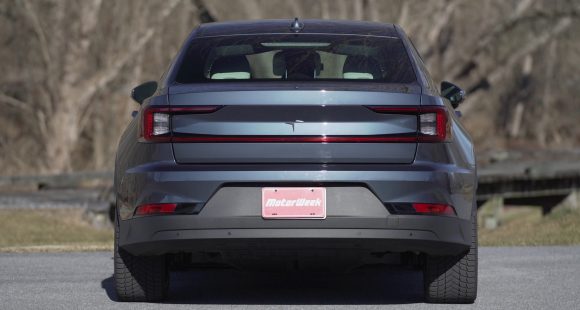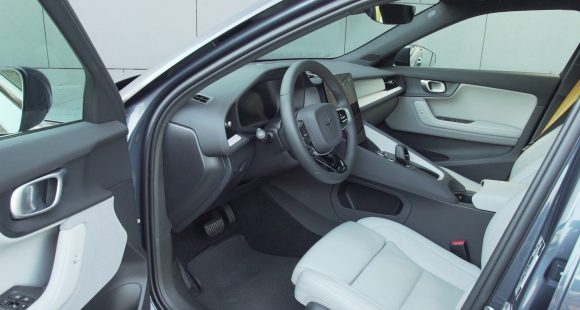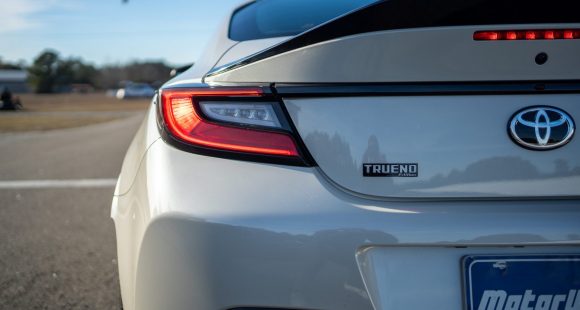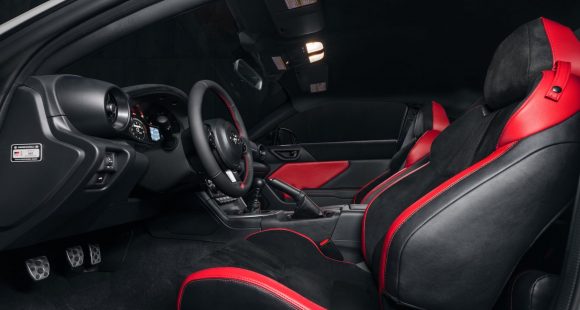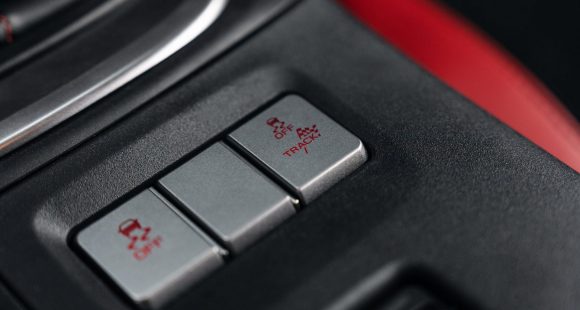2017 Jaguar F-PACE
The Jaguar brand always seemed to be in some type of turmoil, going all the way back to its 60’s heydays. Boy has that changed, these days it appears to have a very solid footing under Tata ownership, producing a string of very impressive vehicles. Notice we didn’t say “cars”. For behold, the F-Pace, Jaguar’s first crossover utility, a “cat” designed to really stir up the market.
Let’s get this straight right out of the box; a Jaguar utility vehicle, as implausible as it may sound, is not really a stretch. After all, Jag’s been partnered with Land Rover since Ford bought the pair in 2000. And during that time, SUVs from luxury brands have gone from a rarity to a necessity. So, this 2017 Jaguar F-PACE shouldn’t be a surprise.
And truth be told, it would have made a fantastic Land Rover. Be that as it may, there are plenty of SUV and crossover sales to go around, and somehow Jaguar resisted the urge to just rebadge a Range Rover, by basing the F-PACE on their own XE/XF sedan chassis. Good call on their part, as it makes it truly unique.
Both the structure and most body panels are aluminum of course, and it looks fantastic, drawing a crowd wherever we parked it. The familiar grille tells everyone what it is; while the 20-inch wheels, with big brakes behind, on this F-Pace S, clue everyone in on its performance potential. Up to 22-inch wheels are available.
 The rear continues the theme established by the F-TYPE, particularly with the LED tail lights. But all-in-all, it looks exactly like you might expect a Jaguar crossover to look like.
The rear continues the theme established by the F-TYPE, particularly with the LED tail lights. But all-in-all, it looks exactly like you might expect a Jaguar crossover to look like.
Powertrain options include 2-different supercharged 3.0-liter V6s, a 340-horsepower version, and the 380-horsepower unit in our S, both rated at 332 lb.-ft. of torque. Plus, a 180-horsepower 2.0-liter I4 turbo-diesel.
All F-PACE’s get an 8-speed automatic transmission with all-wheel-drive.
Behind the wheel, there’s a very familiar Jaguar feel, which is awesome. Smooth and willing. In similar fashion to BMW, Jaguar has established a tremendous brand consistency throughout their lineup.
The F-PACE is also one of those rides that feels faster than you’re expecting, even when you know it’s going to be fast.
F-PACE operates on rear-wheel-drive until traction is lost, at which time in can send 50% of the power forward. Adaptive Surface Progress Control is autonomous driving for off-road, designed for keeping you from hurting your Jag on steep hills or slippery conditions. That’s technology we can get behind; as no doubt it comes from Land Rover. Ground clearance is a fine 8.4-inches.
 Taking full control ourselves, for straight line sprints, this F-PACE S put plenty of power down; leaping off the line to 60 in just 5.2-seconds.
Taking full control ourselves, for straight line sprints, this F-PACE S put plenty of power down; leaping off the line to 60 in just 5.2-seconds.
Gear changes were brisk, the exhaust sounds exotically loud, and in 13.6-seconds we were at the end of the 1/4 mile travelling at 103 miles-per-hour.
Steering was light, tight, and nimble; and overall it handled extremely well. There was bit of expected understeer, but it remained very flat through our cone course.
On the inside, the F-Pace layout is similar to the XE sedan, but materials are a welcomed step above. And we’re glad to finally see an infotainment system worthy of the brand, Jag’s new InTouch Pro features a 10-inch tablet-like interface.
Front seats have substantial bolstering, but also very good comfort and tons of adjustments.
The expected Jag elements, like the pop-up rotary shifter and TFT gauges are present, but there’s plenty of utility as well, with decent rear seat people space, and 33.5 cubic-ft. of seat-up cargo room.
 Government Fuel Economy Ratings are 18-City, 23-Highway, and 20-Combined. We averaged a good 21.7 miles-per-gallon on Premium. The Energy Impact Score is about average, with 16.5-barrels of oil burned and 7.4 tons of CO2 emitted annually.
Government Fuel Economy Ratings are 18-City, 23-Highway, and 20-Combined. We averaged a good 21.7 miles-per-gallon on Premium. The Energy Impact Score is about average, with 16.5-barrels of oil burned and 7.4 tons of CO2 emitted annually.
Get the diesel if you want better, it rates 29-mpg Combined.
With the F-Pace, Jaguar now has the broadest product line in their history. And, there is much to like about their first luxury-ute effort, including a base pricing that is quite low at $41,985. And that’s for the diesel. This F-PACE S starts at $57,695; certainly not awful for a vehicle of this caliber.
So, not only is the F-PACE a great mid-size luxury crossover utility vehicle, it’s a great Jaguar! It handles on par with anything similar from Porsche or BMW; for less than the price of a Tahoe. So, get used to seeing plenty of these cats prowling around stirring up the luxury utility market. The 2017 Jaguar F-Pace is truly one of the most outstanding vehicles we’ve driven this year.
Specifications
- Engine: 3.0 liter
- Horsepower: 380
- Torque: 332 lb.-ft.
- 0-60 mph: 5.2 seconds
- 1/4 mile: 13.6 seconds @ 103 mph
- EPA: 18 mpg city / 23 mpg highway,
- Energy Impact: 15.6 barrels of oil/yr
- CO2 Emissions: 7.4 tons/yr
2024 Polestar 2
More Range And More Power For The Polestar 2
Volvo is well on their way to making the transition to an all-electric brand, but their sister-brand Polestar is already there. Now, we’ve spent lots of time in their all-wheel drive, five-door Polestar 2, having tested it in 2021, and a year later when a two-wheel drive version arrived. But, EV updates are coming quickly. So, let us be your guide for all that’s new with the Polestar 2.
While we are driving more EVs than ever, we’ve also been spending a lot of time recently circling back to ones we’ve previously tested. As in this new era of electrified vehicles, significant updates are arriving quickly, with R&D investments increasing and retrofitting them easier than ever. This is often done through software updates that can even be accomplished over the air. For 2024, the Polestar 2 has indeed gotten some software updates, but some physical ones as well.
Clearly aimed directly at Tesla’s Model 3 when it arrived; the Polestar 2’s build quality was vastly better, but range definitely came up short. So, addressing that was priority No. 1; and for ’24 the Polestar can travel up to 20% farther than before while consuming 9% less energy, and when it comes time to charge it back up, it can do that 34% faster too.
Range in the Single Motor version increases from a max of 270 to 320 miles thanks to a larger 82-kWh battery pack, and that solitary motor now powers the rear wheels, not the front wheels. It’s also bigger, coming in at 220 kW compared to the previous 170 kW front-wheel drive version, going from 231 to 299 horsepower.
Dual Motors keep the same 78-kWh battery, but still sees a boost from 260 to 276 miles and takes advantage of the larger rear motor for a new combined 310-kW output with 421 horsepower. Our test car has the added Performance Pack, which uses an additional 35 kW to deliver 455 horsepower and 546 lb-ft of torque, though max range drops to just 247 miles.
The new battery in rear-drive 2s will also charge faster, now accepting up to 205 kW for an 80% charge in 20 minutes; max for dual-motors stays at 155 kW, which puts an 80% charge at 34 minutes. Using 32 kWh of electricity per 100 miles, the Dual Motor earns a good efficiency rating.
The [Polestar] 2 has always been one of the most enjoyable EVs to drive, even more so now with that additional power coming from the rear motor.
Unfortunately, extremely cold temperatures kept us from seeing that increased range, as we were only on pace for about 194 miles in our test.
The 2 has always been one of the most enjoyable EVs to drive, even more so now with that additional power coming from the rear motor. And especially when equipped with the Performance Pack as it not only includes more power, but adds 20-inch forged wheels, upgraded brakes, and adjustable Ohlins Dual Flow Valve performance dampers. It greatly improves handling prowess without affecting ride quality, and is easily worth the $5,500 charge if you at all enjoy driving.
Even on a 20-degree track day there was plenty of grip through our handling course. No understeer or oversteer, and lots of feedback through the wheel. There was a nice, strong launch off the line that properly planted us firmly in the seat, and rocketed us to 60 in 4.5 seconds. Power delivery stayed pretty intense up until about 80 mph when there was a definite tapering off. Still, it was a 13.4-second quarter-mile at 102 mph; smooth, quiet, and stable the whole way.
When this car debuted, its Google-based infotainment setup was a novelty, but since then, more and more manufacturers are just “Googling it” so it doesn’t seem out of place at all. The wireless phone charger is easy to access, and there’s a great Harmon/Kardon sound system and panoramic sunroof to enhance the in-cabin experience. Exteriors have also been enhanced with a smooth grille insert and new wheel choices.
Hatchback practicality means 14.3 cu-ft of easy to access cargo space with split-folding seatbacks for longer items and expanding the space to 38.7 cu-ft. Plus, there’s even a sizeable storage bin up front under the hood.
Single Motor Polestar 2 pricing now starts at $51,300, with Dual Motors starting at $56,700; topping out at $64,400.
For a car manufacturer that hasn’t even been around for a decade yet, Polestar has kept itself busy, totally transforming their latest model in just a few years, making the 2024 Polestar 2 even more appealing. They are certainly off to a good start, and with a host of Polestars just over the horizon, including some all-important utility vehicles, this star will be shining even brighter.
Specifications
As Tested
- Motor Setup: Dual Motor
- Horsepower: 455
- 0-60 mph: 4.5 seconds
- EPA Range: 247 miles
- Efficiency : 32 kWh / 100 miles
- Battery Size: 78-kWh
- Torque: 546 lb-ft
- 1/4 Mile: 13.4 seconds at 102 mph
- MW Test Loop: ~ 194 miles
- Peak Charging Rate: 155 kW
2024 Toyota GR 86 TRUENO Edition
Paying Tribute to Eight-Six History
The Toyota GR86 may not be the fastest, flashiest or most expensive sport coupe around; but it’s for those very reasons that we consider it near-perfect for folks like us that just want to get out there and drive! For 2024, Toyota is giving us even more to love while also celebrating the origins of the legendary “eighty-six,” with this TRUENO edition.
When the “Gazoo Racing” team got ahold of Toyota’s 86 nameplate to make the GR86 for 2022, we didn’t think it could get any better. Now just two years deep, it turns out it can thanks to a few performance add-ons, and this 2024 Toyota GR86 TRUENO Edition has them all.
It’s okay if you don’t know the original AE86 Sprinter TRUENO this car refers to. For now, just know that the modern rendition celebrates that classic by carrying the same ethos of low-power, rear-wheel drive fun. In lieu of a downhill mountain pass, three days at Savannah’s Roebling Road Raceway sufficed as our playground.
2024 also sees the introduction of the GR86 Performance Package, available on all models and standard on the TRUENO. This $1,500 kit mounts Brembo brakes and SACHS dampers onto Premium grades; and throws in larger 18-inch wheels to Base GR86s to accommodate said brakes, upping package price to about two-grand.
Sure, no extra power; but we felt as fast as ever through Roebling’s nine corners.
The GR86 was already such a fun car to toss around, and these enhancements make it all the better.
The Brembos in particular are something else. Being so lightweight, late braking the 86 has always been easy, and these four-piston fronts and two-piston rears let our foot procrastinate even longer. Diving into corners, turn-ins are crisp with practically zero body roll.
But sometimes you just have to cut a little loose. Put on the throttle at just the right moment and the skinny 215-wide tires give way to steady slides; but they are Michelin Pilot Sport 4s, so there’s plenty of grip when needed.
[This] modern rendition celebrates that [AE86] by carrying the same ethos of low-power, rear-wheel drive fun.
Now, if you were enthralled by our Roebling Track Test of the GR86 two years ago and already went out and bought one, get this: these performance upgrades can be retrofitted on any 2022-and-up GR86 sporting 18-inch wheels.
It is a bit of déjà vu under the hood, seeing the same 2.4-liter 4-cylinder BOXER putting out 228 horsepower and 184 lb-ft of torque. That’s not a lot when stacked up to some other Japanese sports cars, but plenty for a sub-3,000-pound coupe. It’s sent to the rear wheels through a standard Torsen limited-slip diff and a six-speed manual with satisfying throws; though a six-speed automatic is available should you desire.
Our manual tester hit 60 in 5.9 seconds, almost a half second quicker than the automatic model we tested two years prior. The quarter-mile ended in 14.4 seconds at 99 mph, also a tad swifter.
Once we apexed turn nine and hit the front straight, we saw 131 mph before employing those Brembos. No doubt, this GR86 is far more potent than any stock 86 from before.
If you Google the Toyota AE86, you’ll no doubt find the boxy mid-80s hatch wearing a similar white and black “Panda” paint scheme, which this GR86 mirrors quite well; though, red is available too. Either color is contrasted by various black accents: glossy mirrors, door handles and a rear spoiler, joined by side graphics and a wrapped hood. You’ll see “TRUENO” badging adorning the lower front bumper and the rear deck, and the namesake subdued in each side graphic.
Inside, the cabin sports red-trimmed Ultrasuede seats, complimented by red stitching on the wheel and shift boot; and the knob itself gets a special TRUENO-logoed cap.
Plenty of physical controls for HVAC and the sorts, and the screen space respectfully limited to a 7-inch digital gauge cluster and an 8-inch infotainment touchscreen; and smartphone integration makes it easy to queue up your favorite Eurobeat playlist. 2024 does sees more tech for manual models, now including Toyota’s Active Safety Suite with pre-collision braking, adaptive cruise control and more.
Government fuel economy ratings for the GR86 with the manual are 20 city, 27 highway and 22 combined on regular.
Pricing for the 2024 Toyota GR86 starts at $30,395 with delivery. TRUENO pricing starts at $35,815— not a bad leap for a special edition limited to just 860 units here in the U.S.
We still think the Toyota GR86 is the perfect sport coupe for just about anyone, and these performance additions give us all the more reason to say so again. Whether you’re an avid enthusiast or a simple tofu delivery boy or girl with big dreams, the 2024 Toyota GR86 is a solid choice; and this TRUENO Edition may just be the one for you.
Specifications
- Engine: 2.4-liter 4-cylinder BOXER
- Horsepower: 228
- 0-60 mph: 5.9 seconds
- EPA: 20 City / 27 Highway / 22 Combined
- Transmission: 6-speed manual
- Torque: 184 lb-ft
- 1/4 Mile: 14.4 seconds at 99 mph
- Starting Price: $35,815



















